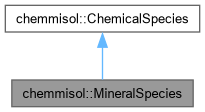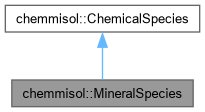#include <species.h>


Public Member Functions | |
| MineralSpecies (const std::string &name, std::size_t index, double solid_concentration, double specific_surface_area, double site_concentration, double fraction) | |
| Phase | getPhase () const override |
| void | incrementConcentration (double extent) override |
| double | concentration () const override |
| double | concentration (double quantity) const override |
| double | quantity (double activity) const override |
| std::complex< double > | quantity (std::complex< double > activity) const override |
| double | activity (double concentration) const override |
| void | setActivity (double activity) override |
 Public Member Functions inherited from chemmisol::ChemicalSpecies Public Member Functions inherited from chemmisol::ChemicalSpecies | |
| const std::string & | getName () const |
| std::size_t | getIndex () const |
| double | activity () const |
| double | quantity () const |
Static Public Member Functions | |
| static double | sites_quantity (double solid_concentration, double specific_surface_area, double site_concentration) |
Additional Inherited Members | |
 Protected Member Functions inherited from chemmisol::ChemicalSpecies Protected Member Functions inherited from chemmisol::ChemicalSpecies | |
| ChemicalSpecies (const std::string &name, std::size_t index) | |
Detailed Description
Mineral species implementation.
A mineral component is a component adsorbed on a mineral (i.e. solid) phase to form surface complexes.
In order to define this concept, we need to introduce the notion of free sites. A free site is a metal hydroxide component integrated in a mineral phase, at the interface with the surrounding solution. Free sites are typically noted =SOH, where S is a metal ion such as Fe or Al.
Mineral species can then be formed fixing aqueous species on free sites. Here is some example reactions (charges are not represented except for H+ for the sake of simplicity), that form the =SOH2 and =SOPO3 MineralComponents:
=SOH + H+ <-> =SOH2 =SOH + PO4 + H+ <-> =SOPO3 + H2O
An AqueousSpecies can also occupy several free sites to form bidentate surface complexes:
2=SOH + PO4 + 2H+ <-> (=SOH)2 PO3 + 2H2O
Such feature is easily represented by stoichiometric coefficients, and does not require any particular consideration as long as mineral components activities are properly defined.
Indeed, the concentration of a MineralSpecies is rather considered as a molar fraction (without unit) rather than a mole concentration (mol/l). To define this fraction, we need to define N, the total quantity of possible free sites. Notice that this is different from the currently free sites: it is a constant representing all the surface sites, occupied and unoccupied. The molar fraction of the MineralSpecies used as concentration() is then defined as n/N where n denotes the current quantity of adsorbed MineralSpecies. The activity of the MineralSpecies is defined equal to this concentration.
See Hiemstra 1996 for more detailed and theoretical considerations about surface complexes.
Constructor & Destructor Documentation
◆ MineralSpecies()
|
inline |
Defines a MineralSpecies.
N is calculated as V * solid_concentration * specific_surface_area * site_concentration. Where V is the arbitrary and constant volume of the solution defined in AqueousSpecies::V.
The molar fraction of the component is initialized from the specified fraction parameter.
- Parameters
-
name Name of the component. index Unique index of the component. solid_concentration Quantity of mineral in suspension in the solution, usually expressed in g/l. specific_surface_area Surface of the solid in contact with the solution per unit of mass, usually expressed in m2/g. site_concentration Quantity of sites per unit of surface in contact with the solution, usually expressed as sites/nm2. fraction Initial molar fraction of this mineral species.
It is the responsibility of the user to ensure unit consistency. Predefined units can be used for this purpose, for example:
using namespace mineral;
MineralSpecies species(
"=SOH2", i,
0.1, // molar fraction, without unit
2.5 * g/l, // solid concentration
24.2 * m2/g, // specific surface area
0.8 * entities/nm2 // site concentration
);
Notice that the previous example is actually consistent, even if the specific surface area is specified as m2 /g and the site concentration is specified in entities/ nm2, since the purpose of the *unit computation is to convert each numerical value to the standard and consistent unit system used internally.
Member Function Documentation
◆ sites_quantity()
|
static |
Computes the total quantity of mineral sites that corresponds to the provided parameters.
The chemmisol unit system should be used to ensure unit consistency.
- Example
- 2.5 * g/l,24.2 * m2/g,0.8 * entities/nm2,);static double sites_quantity(double solid_concentration, double specific_surface_area, double site_concentration)
- Parameters
-
solid_concentration Quantity of mineral in suspension in the solution, usually expressed in g/l. specific_surface_area Surface of the solid in contact with the solution per unit of mass, usually expressed in m2/g. site_concentration Quantity of sites per unit of surface in contact with the solution, usually expressed as sites/nm2.
- Returns
- quantity of sites (mol)
◆ getPhase()
|
inlineoverridevirtual |
Phase of the chemical species.
Implements chemmisol::ChemicalSpecies.
◆ incrementConcentration()
|
inlineoverridevirtual |
Increments the concentration of the current component, considering that its absolute quantity is incremented by extent.
For components in solution, this is typically C = C + extent/V.
- Parameters
-
extent Quantity of the current component added to the system
Implements chemmisol::ChemicalSpecies.
◆ concentration() [1/2]
|
inlineoverridevirtual |
Returns the current concentration of the component.
The theoretical definition of the concentration might vary depending on the nature of the component (aqueous, gaz, mineral...).
- Returns
- Current concentration of the component
Implements chemmisol::ChemicalSpecies.
◆ concentration() [2/2]
|
inlineoverridevirtual |
Computes the concentration of the current component corresponding to the specified quantity.
Notice that quantity might be different from quantity(), and that this call does not modify the concentration of the current component.
- Parameters
-
quantity Quantity of the component
- Returns
- Computed concentration of the component
Implements chemmisol::ChemicalSpecies.
◆ quantity() [1/2]
|
inlineoverridevirtual |
Computes the quantity of the current component corresponding to the specified concentration.
Notice that activity might be different from activity(), and that this call does not modify the quantity of the current component.
- Parameters
-
activity Activity of the component
- Returns
- Computed quantity of the component
Implements chemmisol::ChemicalSpecies.
◆ quantity() [2/2]
|
inlineoverridevirtual |
Implements chemmisol::ChemicalSpecies.
◆ activity()
|
inlineoverridevirtual |
Computes the activity of the current component corresponding to the specified concentration.
Notice that concentration might be different from concentration(), and that this call does not modify the activity of the current component.
- Parameters
-
concentration Concentration of the component
- Returns
- Computed activity of the component
Implements chemmisol::ChemicalSpecies.
◆ setActivity()
|
inlineoverridevirtual |
Sets the activity of the chemical species. The quantity() and concentration() values are updated accordingly.
Implements chemmisol::ChemicalSpecies.
The documentation for this class was generated from the following file:
- include/chemmisol/chemical/species.h